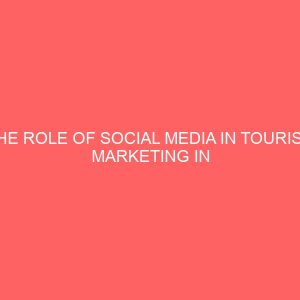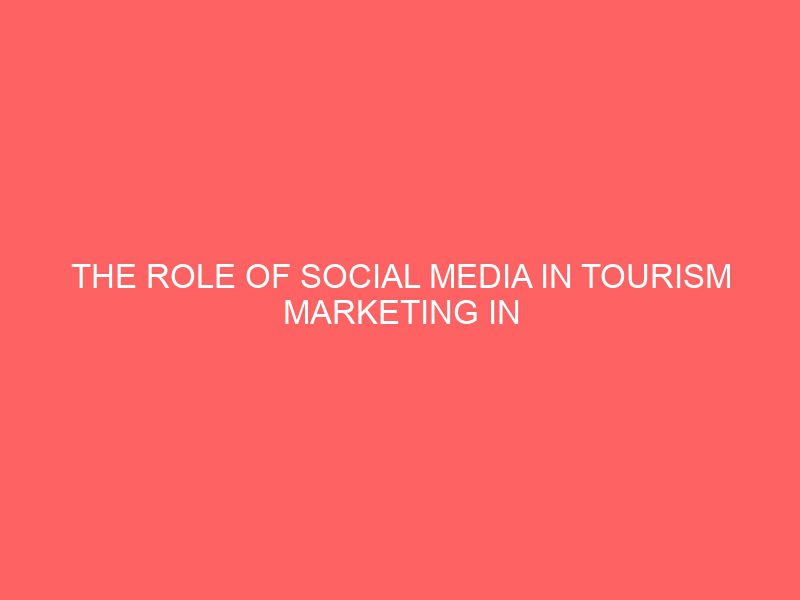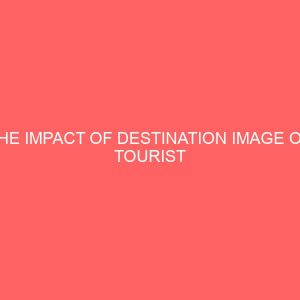Description
ABSTRACT
This project work seeks to investigate the popular use of the social media in the tourism and hospitality industry. Social networking sites strategy is getting popular in the hospitality and tourism industry. Many firms started to use social networking sites for the purpose of communication. In the case of the tourism industry, the communication among consumers has a huge impact on the way a consumer makes their destination decision. Social networking has also given the opportunity for the industries to connect with their consumers and employees in a quick and efficient way.
The wide connection of social networking is a good way to spread information around the world, especially for business promotion and to build the image of a specific brand. On the other hand, it is convenient for a company to target their consumers by using the data given by the consumers who registered an account on the social networking site. Lastly, social networking sites allow everyone and anyone to write their opinions and post it online, which not only brings advantages to the company but also disadvantages because certain users might defames the brand through word of mouth.
CHAPTER ONE
1.0.INTRODUCTION:
Tourism is travel for pleasure; also the theory and practice of touring, the business of attracting, accommodating, and entertaining tourists, and the business of operating tours. Tourism may be international, or within the travellers country. The World Tourism Organization defines tourism more generally, in terms which go beyond the common perception of tourism as being limited to holiday activity only , as people traveling to and staying in places outside their usual environment for not more than one consecutive year for leisure, business and other purposes.
Tourism has become a popular global leisure activity. Tourism can be domestic or international, and international tourism has both incoming and outgoing implications on a countrys balance of payments. Today, tourism is a major source of income for many countries, and affects the economy of both the source and host countries, in some cases being of vital importance.
Tourism suffered as a result of a strong economic slowdown of the late2000s recession, between the second half of 2008 and the end of 2009, and the outbreak of the H1N1 influenza virus, but slowly recovered. International tourism receipts the travel item in the balance of payments grew to US1.03 trillion 740 billion in 2011, corresponding to an increase in real terms of 3.8 from 2010. International tourist arrivals surpassed the milestone of 1 billion tourists globally for the first time in 2012, the same year in which China became the largest spender in international tourism globally with US102 billion, surpassing Germany and United States. China and emerging markets such as Russia and Brazil had significantly increased their spending over the previous decade.
Social media are computermediated tools that allow people to create, share or exchange information, career interests, ideas, and pictures/videos in virtual communities and networks. Social media is defined as a group of Internetbased applications that build on the ideological and technological foundations of Web 2.0, and that allow the creation and exchange of usergenerated content. Furthermore, social media depends on mobile and webbased technologies to create highly interactive platforms through which individuals and communities share, cocreate, discuss, and modify usergenerated content. They introduce substantial and pervasive changes to communication between businesses, organizations, communities, and individuals. These changes are the focus of the emerging field of techno selfstudies. Social media differ from traditional or industrial media in many ways, including quality, reach, frequency, usability, immediacy and permanence. Social media operates in a dialogic transmission system, many sources to many receivers. This is in contrast to traditional media that operates under a monologic transmission model one source to many receivers.
The rise in popularity of social networking sites has led social networking to become a global phenomenon. After many countries gained Internet access, the increase in the use of Internet started influencing the economy and social life at the beginning of 20th century Milano, Baggio amp; Piattelli, 2011. Later on, in the era of Web 2.0, as social networking advanced, an increasing number of users on the Internet began to participate in social networking websites and this has resulted in the system of social networking to change Milano, Baggio amp; Piattelli, 2011; Seth, 2012.According to Clark and Robert 2010, social networking sites are now mainly used for job networking, targeted marketing, and entertainment. p.507.
Social networking is a type of social media; social networking sites allow Internet users to connect with people and create information. Social networking sites are originally used for entertainment purposes however an increase in the use of Internet and information communication technologies has shifted the way people communicate with each other, mainly in the tourism and tourism industries Assenov amp; Khurana, 2012; Clark amp; Roberts, 2010. For instance, social networking sites like Facebook allow registered users to interact globally and freely with people who share the Author: Same interest by uploading photos, sharing posts, chatting, commenting on the posts and also getting replies, such features allow companies to get quick feedback from consumers whereas consumers are able to receive responses immediately. These software and technology features which are available on social networking sites are also part of the Web 2.0 system Seth, 2012. Web 2.0 has also given popularity to user generated content UGC where information is gathered from different online sources all of which collaborate to form the final source Seth, 2012, p. 9. UGC has replaced traditional marketing in terms of media advertising. The advertisements are often sponsored posts promoted by people on social networking sites and these online advertisements appear to be more trustworthy than advertisements from mass media like televisions, radio, newspaper and magazines Li amp; Darban, 2012. Manap and Adzharudin pointed out that consumers were more likely to be convinced to buy a product that is recommended by people who had experienced it experience good rather than a search good, the researchers also stated that it is possible to frequently utilize this strategy in the tourism industry. 2013
The change in consumer behavior is majorly affected by the social networking sites which provide platforms for consumers to connect with the company and other consumers Bilgihan, Peng amp; Kandampully, 2014.The explosive growth of the population of Internet user son social networking sites has had a huge impact on tourism and tourism industry whereby consumers are changing the rule of marketing. In order for a company to be successful in business, it is necessary for marketers to make decisions based on consumer needs, changes in society and also the development of technology. By doing, it not only satisfies consumers but also strengthens the relationship with customers to ensure they make a comeback. In addition, social networking sites also help to record the information of consumers so that it is easy to be obtained whenever needed Assenov amp; Khurana, 2012. In addition, social networking sites also provide social communication services which could create brand awareness and build a good image for the brand Bilgihan, Peng amp; Kandampully, 2014.
There are many effects that stem from internet usage. According to Nielsen, internet users continue to spend more time with social media sites than any other type of site. At the same time, the total time spent on social media in the U.S. across PC and mobile devices increased by 99 percent to 121 billion minutes in July 2012 compared to 66 billion minutes in July 2011. For content contributors, the benefits of participating in social media have gone beyond simply social sharing to building reputation and bringing in career opportunities and monetary income, as discussed in Tang, Gu, and Whinston 2012.
One of the most competitive fields of Service sector is tourism industry, which requires effective management of natural, financial and human resources existing in country. For developing tourism industry in any country it is therefore important to provide relevant Infrastructure, improve service quality and increase of customer satisfaction. The essence of successful marketing is to provide sufficient value to gain loyal, longterm customers. There are different types of instruments in marketing, which aims to achieve of customer satisfaction and loathly. Social media is a crucial tool for success in business today. People are already talking about the business using social media, companies could establish good relations directly to the customers. Use of the internet for booking tends to be higher in countries that have high internet penetration levels and usage of credit cards, especial in the USA and UK. But the highest levels, interestingly, can be found in some smaller Travel and Tourism markets such as Scandinavia 65 and higher and Australia. Globally, different estimates suggest that more than 50 of leisure trips and 40 of business trips are booked online. By 2014, over 3 billion of the worlds adult population will be able to transact electronically via mobile or internet technology with a 90 mobile penetration rate and 6.5 billion mobile connections. Travel and Tourism, World Travel Tourism Council in 2011 Social media refers the activities of different customers in the society, gathering and sharing online information and knowledge. Marketers know that theoretically, social media should be a powerful way to generate sustainable, positive wordofmouth marketing. It is very important that marketers select the right social media platform, design the right message and engage the right users to spread that message for implementing successful campaign. Tourism review team works daily with a number of collaborative media for tourism industry and attracting millions visitors from different countries. Facebook, Twitter, YouTube, Podcasts and travel shake are the best known and effective social media networks for marketing in tourism and tourism industry. The impact and usage of social media marketing strategies are very crucial for satisfying tourist demand in the global world. The creation and accessibility of internet space has radically changed tourists motivation to plan and book trips with different destination. Companies grow their confidence and familiarity with the social web to receive all successful information from researching travel on websites.
To access new information technology now is very easy and this has radically altered the way in which information is created and disseminated. Accordingly, marketers have possibility to use social media to stimulate and encourage interaction of customers to facilitate developing awareness of tourists in through the country.
It has already been mentioned, that business increasingly acknowledge the potential role of the online social networks as marketing instruments LorenzoRomero et al., 2011, p.171. Going a step beyond, the multiple possibilities of the internet as a means of communication among consumers, as well as between consumers and companies, allow for the emergence of new forms of social relationships as well as new marketing approaches, both in terms of selling, promotion and relational paradigms Pinho and Soares, 2011, p.116 That is why the advent of social networking sites SNS has offered new opportunities to companies and their brands; especially promoting their brands, products and services. According to LorenzoRomero et al. 2011, p.172 social networking sites not only offer users the possibility of networking with each other, but also users can become consumers; this means that users have the chance to gather more information about the brands/products/services they prefer, through user reviews, making thus better buying decisions. Consequently, creating social networking environments and motivating customers and prospects to use them, lead to engagement with the customers and increasing customer trust and loyalty. According to Pinho and Soares 2011, social networks, like Facebook and to a lesser extent Twitter, increasingly gain the epicenter of attention in the practitioners community, in terms of their marketing impact, especially as a communication tool. In other words, even though the expansion of Facebook is immense; there is not enough academic research on its impact to companies and particularly to the tourist industry. More specifically, it would be interesting to investigate how the use of Facebook as an aspect of social media can have a certain impact on tourism consumer behaviour in general and decision making process in particular. The aim of this paper is to point out how social media tools like Facebook Fan Pages could actually have an impact to the tourism consumer behaviour, which ultimately will lead to the final selection of the service offered by Greek Bus Operators GBOs. Through social media marketing, GBOs can achieve maximum customer engagement, which in turn can increase customer satisfaction and loyalty. Thus, customer engagement and relationship marketing ultimately turns customers into fans of the product. Consecutively, the total tourist consumer behaviour changes, which in turn leads GBOs to use social media marketing for their own competitive advantage, in comparison with other tourism operators.
1.1.BACKGROUND OF THE STUDY:
The emergence of Web 2.0, allows one with unlimited amount of things the individual can do on the internet these days. The individual is not just restricted to emails or passively absorbing the static information that is available on the web pages when browsing. It used to be oneway but now the web is the platform where people can share information, hold a decent dialogue, build both social and business connections.
Social media has recently been adopted by a small group of organizations integrated marketing plans. There by infusing a mix of advertisement, public relations, their sales promotion to produce a customer focused message. With the evolution of platforms such as LinkedIn, Facebook, Twitter and YouTube, we have the opportunity for exceptional access to the guest Lanz, Fischhof, amp; Lee, 2010. Since social media is so available to anyone with an internet connection, it should be a platform that can be recommended to the tourism industry to increase their brand awareness and facilitate direct feedback from their customers.
A business that understands the advantage of social media is well aware that social media is essential in developing new business in the current competitive and online driven marketplace.
Marketing is an important aspect for any company involved in business. As such, it is a competitive world out there, and social media marketing is the new kid in town and it can reach out to the people accessing these social media platform regularly. Communication is essential for any corporation and business, therefore either they change the way information is conveyed or be prepared to lose some of the audience. It is imperative for marketing managers to continuously find a solution to appeal, keep new and current consumers Schneider, 2009. Social network is the ideal platform for communication that applies perfectly with marketing in the virtual world. Social networks are groups of individuals who prefer to communicate with one another through a preferred site based on the profile created for themselves Laudon and Traver, 2007. It is on this note that the background of this study was formed.
Rivers State was created out of the old Eastern Region of Nigeria on May 27, 1967 before Bayelsa State was later carved out of it in 1996. Rivers state, named after the many rivers that border its territory, was part of the Oil Rivers Protectorate from 1885 till 1893, when it became part of the Niger Coast Protectorate. In 1900 the region was merged with the chartered territories of the Royal Niger Company to form the colony of Southern Nigeria.
The state has a population of about 5 million people who have a rich and unique cultural heritage. Usually known to be friendly and hospitable, these people come from various ethnic nationalities namely; Abua, Andoni, Ekpeye, Engenni, Etche, lbani , lkwerre, Kalabari, Ndoni, Okrika, Ogoni etc. These ethnic groups have existed together for centuries, long before the creation of the state and are currently distributed in twenty three Local Government Areas. Port Harcourt the state capital is Nigerias second largest commercial and agricultural centre and has the second busiest seaport in Nigeria.
Covering a total of 11,077km land area, Rivers State is bounded in the south by the Atlantic Ocean, in the north by Anambra, Imo and Abia States, in the east by Akwa Ibom state and in the west by Bayelsa and Delta States. The state is located in the southern part of Nigeria in which the inland part of Rivers State consists of tropical rainforest, towards the coast. The typical river delta environment features many mangrove swamps. The state accounts for more than 40 of the crude oil production in the country.
Rainfall in Rivers State is seasonal, variable and heavy. Generally, rain occurs, on the average, every month of the year, but with varying duration. The state is characterised by high rainfall, which decreases from south to north. Total annual rainfall decreases from about 4,700 mm on the coast to about 1,700 mm in extreme north of the state. It is 4,698 mm at Bonny along the coast and 1,862 mm at Deqema. For Port Harcourt, the rainy days are about 182 with mean maximum monthly temperatures that range from 28C to 33C, while the mean minimum monthly temperatures are in the range of 17C to 24C. The mean monthly temperature is in the range of 25C to 28C. The mean annual temperature for the state is 26C. The hottest months are February to May. The difference between the dry season and wet season temperatures is only about 2C. Relative humidity is high in the State throughout the year and decreases slightly in the dry season.
1.3.STATEMENT OF RESEARCH PROBLEM:
The tourism industry tends to be very customercentric and also one that prides itself by reaching out to its guests and providing a personalized experience. In traditional marketing, our lives are saturated by print media, radio and television. The downside of traditional marketing is the high cost and it is a oneway communication. Social media encourages customer engagement, and it being on Web 2.0, promotes twoway traffic. It allows for a faster response and a low cost investment than is typically achieved with traditional marketing.
1.4.OBJECTIVES OF THE STUDY:
1.To draw immediate attention to Tourism development in Rivers State.
2.To provide leisure and recreational faculties in the Local Government area of the State that will attract tourist.
3.To reawaken interest and active participation of all stakeholders in the development of Rivers State Culture towards economic wellbeing of the people this will directly and indirectly attract tourist.
4.To identity the Cultural diversity and heritage of the state for proper management and utilization.
5.To regulate, categorize, standardize and control tourisms, restaurants, fast foods, travel agencies, four operators and other tourism related enterprises.
6.To explore means of utilizing the mass media to boost and advertise the few tourist centres in Rivers state to the world and provide a user friendly web page where tourist can make their enquiries and bookings
1.5.SIGNIFICANCE OF THE STUDY:
Currently the hype surrounding social media strategies for marketing is on the increase, but tourism industry is still trying to cope and see the advantage from the latest trends on the internet. Social media such as Facebook and Twitter is growing daily. Challenges faced by tourisms is the how to engage the consumers and to lead them towards becoming a guest or share their experience for the tourism within their virtual network. For the past decades, the Internet has gradually changed to a stage where the search engines takes control of website traffic .Therefore, businesses that jumped onto the social media wagon earlier see the pay off , as they have established their relationships and viral networks Walsh, 2010.
The research conducted in this manuscript will attempt to give an insight to the tourism industry on the effects of social media, furthermore to establish if social media is effective and recommended, and if so, provide an insight and proposition for adopting social media as a platform for marketing purpose.
1.6.RESEARCH QUESTIONS:
For the course of this research work the researcher framed out some research question which shall guide the researcher to carry out this research work successfully, the research question will be administered to the respondents and samples of the research question are.
1.Have you ever been able to use the social media network in reaching out to target customer
2.Can the social media be a source of advertisement off you industry to the people
3.The number of guest turned in how many are from the source of the social media
4.Do you have an official web address/website where commerce can be carried out
5.Apart from the social media, which other means do your industry use in reaching out to people as a promotional scheme








Reviews
There are no reviews yet.